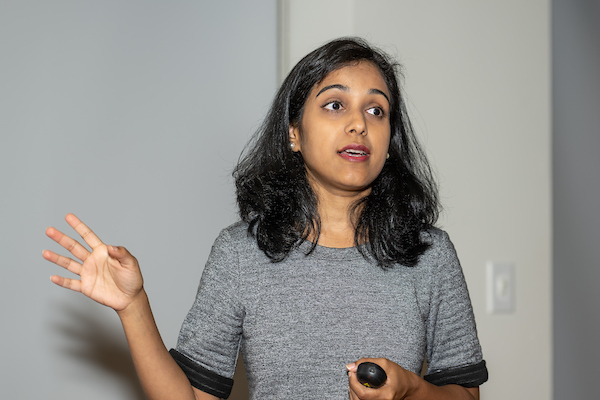Twice each semester, Â鶹ľ«Ńˇâ€™s Division of Research and Sponsored Programs hosts Research & Innovation Forums, to bring together faculty members to publicly present their ongoing work.
Earlier this year, the Carnegie Classification of Institutions of Higher Education awarded Â鶹ľ«Ńˇthe esteemed R1 status for research – the highest recognition that doctoral universities can receive – and the forums allow faculty researchers to display their work internally.
“It is inspiring to see the breadth of excellence that is happening here at Kent State,” said Doug Delahanty, Ph.D., interim vice president for Research and Sponsored Programs. 
The forums, which began in 2016, were put on hiatus during the pandemic, but returned in 2021 and are back to drawing sizable crowds, he said.
While the events offer a forum for professors to talk about their research and findings, one of the main benefits is for other faculty members to see what their colleagues are working on, facilitate the sharing of ideas and foster collaboration among researchers across various disciplines, he said.
“Inevitably, I will hear from someone after, `I didn’t know someone right here on my campus was doing that,'” Delahanty said.
The forums are most often attended by other faculty members, but students and all members of the university community always are welcome to attend, he said. Most often the forums feature presentations from varied disciplines, combining speakers who conduct laboratory science, social science and work in the arts and humanities, although sometimes they will follow a specific theme.
At a forum on Sept. 14, the following research was presented:

As a fashion educator, Bhaduri wanted to examine whether consumers were willing to hold corporations to the same moral standards to which they might hold individuals.
“I was always intrigued by negative things going on with corporations. Specifically, when a corporation says one thing and then does something that is not in moral alignment, what happens?” she explained.
Her findings concluded that corporate hypocrisy may lead to negative consumer reactions, including bad word-of-mouth and even boycotts. Employees of such companies, however, may not react because an employee may be desensitized to the company’s ways. Some employees, however, may leave companies that they find to be amoral.
The findings, she said, are important because sales from brand loyalty account for about 80% of most corporations’ revenue.
The next phase of her research will look at how consumers and employees react to such corporate behavior, based on age.
Hossein Mirinejad, Ph.D., assistant professor in the College of Aeronautics and Engineering, is conducting National Science Foundation-funded research into automated medical systems: “Precision Dosing in Critical Care: An Automated Modeling and Control Approach.”
Mirinejad, who established the within his college, conducts research into how automated devices can help to improve medical systems.
He is exploring how automating fluid therapy can restore blood volume in cases where patients have lost a significant amount of blood; improving this process can directly impact more than 30 million patients who receive fluid therapies annually.
The benefits of automated devices versus having a clinician perform the work, he said, would be the precision that an automated device can provide for dosing and the elimination of human error. During lengthy processes, such as kidney dialysis, it could free up a clinician’s time and would be beneficial during times such as the pandemic, when medical staffing cannot meet the demand for patient care.
presented her research, “Math Misconceptions Abound When Adults Reason About COVID-19 Health Statistics.”

Thompson attributed this error to the whole number bias, in which larger numbers are perceived as a greater percentage, for example, 500/1,000 is seen as greater than ½, because the numbers themselves are larger.
With the onset of the COVID-19 pandemic, Thompson was intrigued by how the whole number bias may have led people to misunderstand fatality statistics and risks associated with the COVID-19 infection.
After studying a group of about 1,300 adults, Thompson’s research concluded that while confusion with math fractions is widespread at the outset, with a short educational intervention, people can learn how to correctly interpret the statistics and will retain that knowledge.
The next forum is set for Tuesday, Nov. 8, at 3:30 p.m. in the Kent Student Center Ballroom Balcony. Refreshments are served.
Learn more about the Division of Research and Sponsored Programs here.

